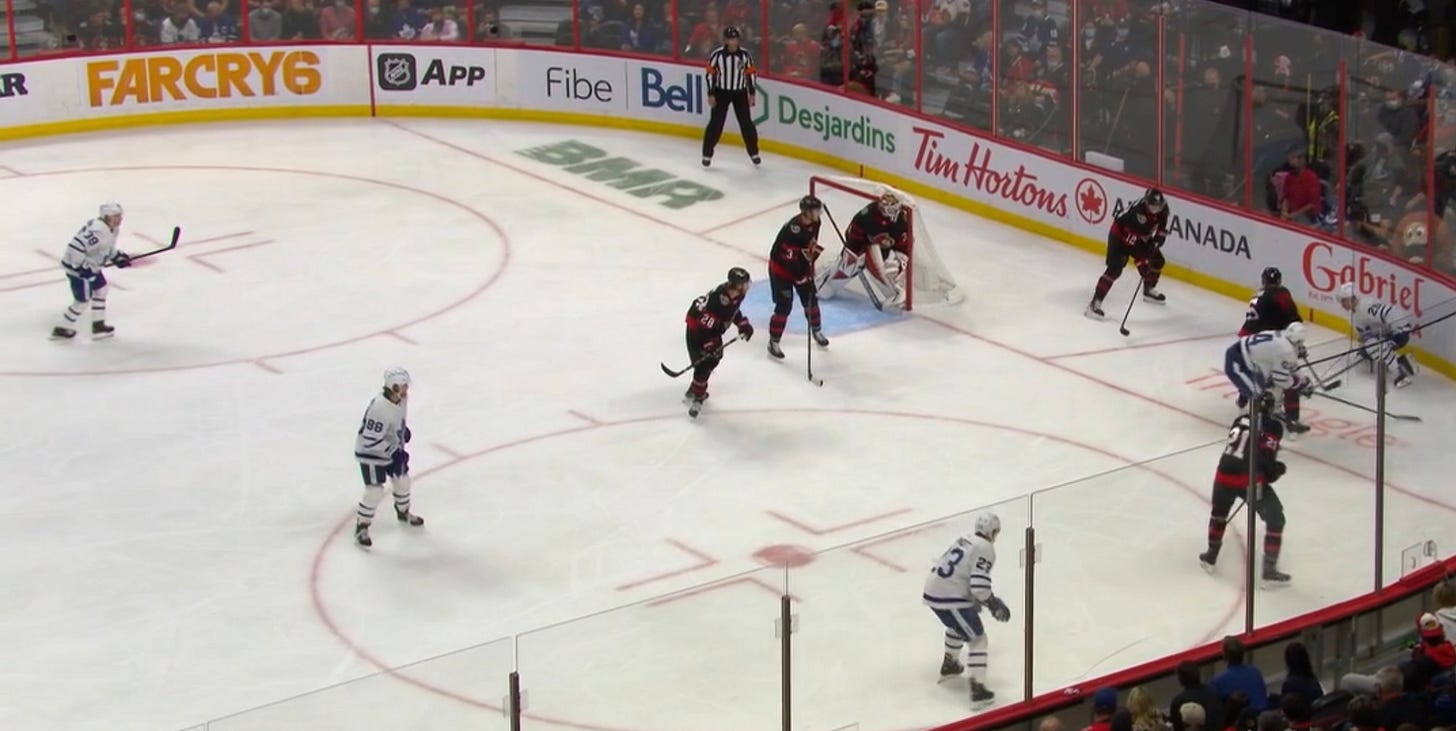As a defenseman, there is a large and often risky decision to make:
To pinch, or
To back away
If a defenseman pinches and loses the situation there is a large probability that the opposition has an odd-person rush on their goalie. Their coach will not be happy when they get back to the bench.
Let’s dive into this decision today. What information do we need to think about to make the best decision in our situation?
The Pinch
Simply put, a pinch is when a defender dives down in the hope to kill the breakout and keep the puck into the zone.
Commonly it’s a defenseman starting on the blueline at the boards and skating forwards down the wall/boards to confront a winger around the outside hashmarks.
Here is an example of a pinch. Is it good? Is it poor? Why?
By the end of this newsletter, you’ll be able to tell everyone good/poor and why.
There are 3 main things to consider
Numbers
Speed
Cleanliness
Numbers
Know where the opposition is
The first rule any defenseman is taught is to count numbers. How many opponents are in front of me? Are there any behind me?
Every defenseman knows to count the number of players in front of them. If there are only 3 or 4, then someone is clearly behind them and likely needs addressed.
Forward #3 High
Most hockey teams preach to have a 3rd player high with the defensemen. This is a support player for the defenseman and for the forwards lower in the zone.
When deciding whether to pinch, looking and reading if there is an F3 high can alter the decision to pinch or not. If there is support from F3, there is a lower risk if the pinch down does not work.
Weakside winger movement
Another person to read is the opposing weakside winger. Their movement dictates options and tactics for both teams. Is that player coming across the ice between the 2 defensemen? Does the weakside winger stay wide to give width?
Understanding that allows us to see if a chip off the wall or far side pass is the likely option for the players we are going to be pinching down upon.
Speed
Second layer speed
The most dangerous thing in hockey is a speed differential. Positive and negative speed differentials dictate space creation.
In our case, we are looking at the opposing center. Most strong side wingers do not have good speed so their main threat is a pass. The most dangerous pass options are the ones with a speed differential. If the center is gaining speed, a simple chip or bump pass is an easy way to break the pinch and get an odd-person rush.
Breakout Options
Is the strong side winger on an island? If the puck is passed to them, will they have options to make a play?
The most common thing to think about is if a “chip” or “ middle bump pass” can beat you easily. If so, a pinch is likely a poor option.
Cleanliness
Puck Cleanliness
A crisp tape-to-tape pass makes the next play much easier on the strong side winger. A rimmed puck that needs to be picked off the boards? Not so much.
I’ve been around many coaches that talk about a defenseman’s cue to pinch is on a rimmed puck. Everyone knows it’s coming and that another play must cover for that pinching defensemen.
Opposition (winger) Situational Awareness
If a winger is staring at the person about to pass them the puck and has not shoulder checked to see what is going on around them, they aren’t likely to understand the next play very well. Their forethought is effectively none and therefore can be a great target for a pinch.
Setting up for Success
Before defensemen decide to pinch they can set themselves up for success. A great example is to have a small gap (space between defender and attacker). A common strategy that is deployed these days is called “Shorting the O-Zone.”
Simply put, the defender moves off the blueline and positions themselves closer to the opposition. Unless a player is threatening to get behind them, the defenders go lowers in the zone.
Here is an example of the 5 players in white “shorting the zone.” Any passes made to a player in dark will result in an immediate battle and difficult situation for the dark team to handle.
Summary, Mental Checklist
When making a quick decision, any player can go through a quick mental checklist before deciding to pinch or not. Here is an example:
Numbers - Do I have F3 support?
Speed - Am I effectively a cone to go around or actually disrupting play?
Cleanliness - What are the chances the opposition can execute?
Here is an element from each of our key areas of focus:
Numbers - All opponents were accounted for
Speed - The opponents failed to build a speed differential
Cleanliness - Opponents failed to shoulder check for threats
To answer the question from the beginning, Is it a good time to pinch?
You have the cues, what is your read through each step of this mental checklist?
Numbers
Speed
Cleanliness
Further Reading
Did you enjoy this newsletter?
Help us spread the ideas within and share it with the people you care about






